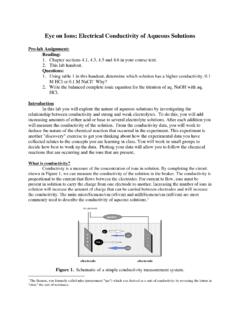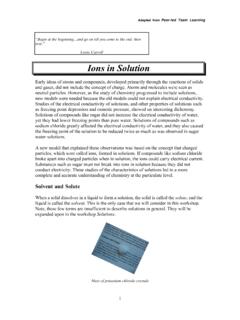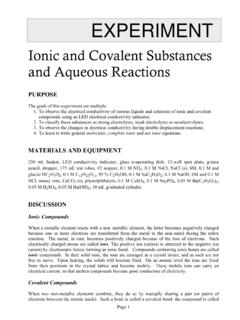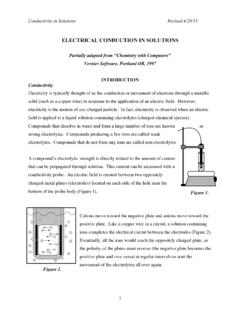Transcription of ComputationofElectricalConductivityofMulticomponentAqueous ...
1 Computation of Electrical Conductivity of Multicomponent AqueousSystems in Wide Concentration and Temperature RangesAndrzej Anderko* and Malgorzata M. LenckaOLI Systems Inc., 108 American Road, Morris Plains, New Jersey 07950A comprehensive model for calculating the electrical conductivity of multicomponent aqueoussystems has been developed. In the infinite-dilution limit, the temperature dependence of ionicconductivities is calculated on the basis of the concept of structure-breaking and structure-making ions. At finite concentrations, the concentration dependence of conductivity is calculatedfrom the dielectric continuum-based mean-spherical-approximation (MSA) theory for theunrestricted primitive model.
2 The MSA theory has been extended to concentrated solutions byusing effective ionic radii. A mixing rule has been developed to predict the conductivity ofmulticomponent systems from those of constituent binary cation-anion subsystems. The effectsof complexation are taken into account through a comprehensive speciation model coupled witha technique for predicting the limiting conductivities of complex species from those of simpleions. The model reproduces the conductivity of aqueous systems ranging from dilute toconcentrated solutions (up to 30 mol/kg) at temperatures up to 573 K with an accuracy that issufficient for modeling industrially important systems.
3 In particular, the conductivity ofmulticomponent systems can be accurately predicted using data for single-solute conductivity is one of the principal trans-port properties of aqueous electrolyte systems. Inengineering applications, the knowledge of electricalconductivity is important for the design and optimiza-tion of electrolysis processes and electrochemical powersources. In the area of corrosion protection, electricalconductivity provides useful information for assessingthe corrosivity of aqueous media and for the design ofcathodic protection systems.
4 Also, conductivity is usedto gain insight into the properties of electrolyte solutionsand to evaluate characteristic quantities such as dis-sociation comprehensive model for electrical conductivity hasto include methods for computing limiting conductivitiesof ions and the composition dependence of conductivityat finite concentrations. Limiting ionic conductivitiescharacterize the mobility of ions in the infinite-dilutionlimit. They provide a starting point for the computationof electrical conductivity at finite concentrations and arenecessary as input for most theories of the concentrationdependence of conductivity.
5 The available theories oflimiting conductivity are based on the continuum-mechanics dielectric friction approach (Hubbard, 1978;Hubbard and Kayser, 1982). The dielectric frictiontheory makes it possible to gain insight into the mobilityof charged spheres in a dielectric continuum. However,it is not suitable as an engineering-oriented, predictivemodel because it does not include structural effects ofion-water interactions (cf. a review by Evans et al.,1979; Ibuki and Nakahara, 1987). Using a moreempirical approach, Marshall (1987) has developed areduced-state relationship that emphasizes density ef-fects at high temperatures.
6 This relationship has beendeveloped for a limited number of ions for whichextensive data are available. Several studies haveshown that limiting conductivity is primarily deter-mined by structural effects caused by interactions ofions with the hydrogen-bonded network of water mol-ecules (Kay and Evans, 1966; Kay et al., 1968). Ac-cordingly, the temperature dependence of limiting con-ductivities depends on the structure-breaking andstructure-making properties of ions. However, no fullyquantitative technique is available that would make itpossible to correlate and extrapolate limiting conductiv-ity data with respect to temperature for all ions thatare of industrial concentration dependence of electrical conductiv-ity has been extensively investigated for dilute aqueoussolutions.
7 A limiting law for conductivity was developedby Onsager (1926) by using the Debye-Hu ckel (1924)equilibrium distribution functions. This law was laterextended by several authors as a power series inc1/2,with additional nonanalytic terms inclnc. Variousclassical theories of electrical conductivity in dilutesolutions have been reviewed by Justice (1983). Theclassical theories, based on combining Onsager s contin-uity expressions with the Debye-Hu ckel distributionfunctions, are generally valid for concentrations up to10-2mol/dm3. Recently, Bernard et al.
8 (1992) and Turqet al. (1995) combined the Onsager continuity equationswith equilibrium distribution functions calculated forthe unrestricted primitive model using the mean spheri-cal approximation (MSA). The MSA theory accuratelyrepresents the properties of electrolyte solutions in thelimit of the primitive model, , up to approximately 1mol/dm3. Thus, it provides a major improvement overthe Debye-Hu ckel theory. However, the analyticalMSA theory has been developed for systems containingonly a single cation-anion pair. Therefore, there is aneed for a comprehensive model that would be capableof reproducing the conductivity of multicomponentsystems in a full concentration range that is of interestfor industrial comprehensive, engineering-oriented model shouldsatisfy a number of requirements:(1) The model should predict the limiting conductivi-ties of individual ions in wide temperature ranges evenwhen experimental data are available only at ambienttemperatures.
9 * To whom correspondence should be addressed. Tele-phone: (201)539-4996. Fax: (201)539-5922. E-mail: Eng. Chem. ,36,1932-1943S0888-5885(96)00590-8 CCC: $ 1997 American Chemical Society(2) It should reproduce the conductivity of systemsranging from infinitely dilute to very concentrated.(3) The conductivity of multicomponent systems shouldbe reasonably predicted on the basis of informationobtained from single-solute systems.(4) The effects of complexation or hydrolysis onconductivity should be taken into account in accordancewith reasonable speciation this work, we develop a model that satisfies theserequirements and verify its performance for selectedaqueous systems with single and multiple Dependence of LimitingConductivitiesThe limiting ionic conductivities are usually knownat one temperature (such as K) or over narrowtemperature ranges.
10 There are only 20 ions ( , H+,Li+,Na+,K+,Rb+,Cs+,Ag+,NH4+,Mg2+,Ca2+ ,Ba2+,Cl-,Br-,NO3-, CNS-, ClO4-,I-,OH-, HSO4-, andSO42-) for which the available experimental data extendat least up to 473 K (Horvath, 1985; Quist and Marshall,1965; Marshall, 1987). To express the temperaturedependence of limiting conductivities, it is convenientto use the equation of Smolyakov (1969), 0is the limiting conductivity, is the viscosityof pure water, andAandBare adjustable 1 does not include any density effects, whichhave been shown to become important at high pressuresand temperatures.









